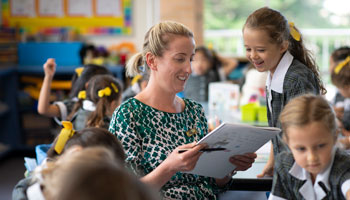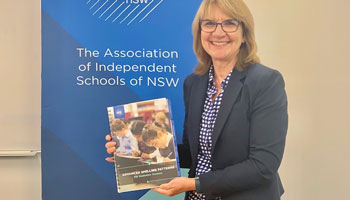A new primary spelling course is showing teachers that while past strategies worked for some, there is a formula that offers greater consistency and success.
When AISNSW Education Consultant Jill Ryman was a new teacher her natural inclination was to teach spelling to her students the way she had learnt. Yet, despite her absolute passion for the subject, it didn’t always go according to plan.
“I was always a good speller and so I just taught it the way I was taught – through lists of random words,” Jill says.
“However, there were some students who consistently made spelling errors. One young student who I just couldn’t work out how to help stands out in my memory. I can still see his face. If only I knew then what I know now.”

AISNSW Student Services Education Consultant Jill Ryman says spelling requires explicit teaching.
“A common question that teachers ask is, ‘Why can they get the words right on the test, but they don’t spell them correctly in their writing?’"
It is a common dilemma among teachers because there is no one set way to teach spelling. Teachers report they do not feel confident teaching spelling, and like Jill, they learned to spell by memorising words.
“They received the list on Monday, were tested Friday, and the words were then put away for a new list,” Jill says.
“A common question that teachers ask is, ‘Why can they get the words right on the test, but they don’t spell them correctly in their writing?’
“It’s because they’re just memorising a list of words. The evidence shows that teachers need to understand why words are spelled the way they are and to explicitly teach that knowledge to students, so they retain and apply spellings when they write.”

The evidence shows that teachers need to understand why words are spelled the way they are and to explicitly teach that knowledge.
Teaching spelling is not simply a task within the English syllabus but a discipline, an art, a world that has its own meta-language, method, culture and strategy.
Now with a Master of Special Education and a special project in Effective Spelling Instruction, Jill says that teaching spelling is not simply a task within the English syllabus but a discipline, an art, a world that has its own meta-language, method, culture and strategy.
Jill says the keys to being a good spelling teacher are understanding the three linguistic elements:
- phonology – how to sound out words, how to break them down into syllables and sounds
- orthography – understanding the common patterns that the English language has
- morphology and etymology – the history of words along with the meaningful parts of words.
“You need to know about the etymology of words, the history of words as well as the patterns of English spelling,” Jill says.
But with 26 letters, 44 sounds and more than 300 letter combinations, how can a busy teacher take it all in?

Students learn and recall spelling when they understand why it is spelled the way it is, its history and patterns.
Over the past two years Jill has helped to create Primary Spelling, an AISNSW exclusive course that addresses the explicit teaching requirements of the draft K-2 English syllabus.
Primary Spelling Support
Jill says to learn these rules, strategies and teaching skills requires professional learning and demonstrations to reinforce how it is done. Over the past two years, Jill has helped to create Primary Spelling, an AISNSW exclusive course that addresses the explicit teaching requirements of the draft K-2 English syllabus.
Primary Spelling is made up of four professional learning modules that include information and strategies for incorporating phonology, orthography, morphology, irregular word spelling and diagnostic assessment of these spelling components to inform instruction.
The content is underpinned by empirical research about the acquisition of spelling skills. This research clearly articulates what the critical components of spelling instruction should include and how to go about providing this instruction in a systematic and explicit way.

The AISNSW Advanced Spelling Patterns for Australian Teachers handbook offers clear strategies for teaching spelling.
"I just love the confidence teachers gain in knowing the strategies, and the certainty that it provides in their ability to teach spelling.”
Classroom resources are provided including handouts, PowerPoint lessons, a suggested Spelling Sequence, and the Advanced Spelling Patterns for Australian Teachers handbook. This handbook provides an overview of Australian spelling patterns and rules, and, importantly, strategies for how to teach these. Between school visits from the consultant, teachers access professional readings and videos about the explicit teaching of spelling.
The feedback Jill has already received is schools appreciate the consistency across K-6.
“Teachers and the school leaders really love that everyone is getting the same information, everyone is using the same language. I just love the confidence teachers gain in knowing the strategies, and the certainty that it provides in their ability to teach spelling.”
For more information on Primary Spelling please see this link.
School credit with thanks: Kambala School, Green Point Christian College.
New to AISNSW and want to receive AISNSW Education News updates? Click here to register, and select ‘AISNSW Education News’ on the Areas of Interest/Subscriptions page.